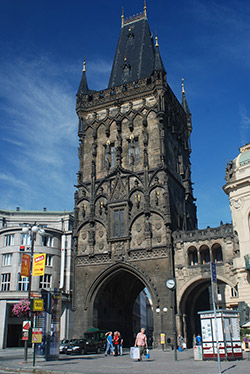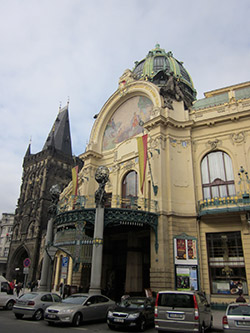






with an iSegway guide was the best fun in town"
Powder Tower
 During your quiet Segway ride under the Powder Tower on your Prague Segway Tour, your private guide will be ready to recount you everything important about this gem. Usually in Prague, while standing on Segway, people yearn to drive further and rather wonder where their Segway trip will bring them, you can also learn about this monument a little more here.
During your quiet Segway ride under the Powder Tower on your Prague Segway Tour, your private guide will be ready to recount you everything important about this gem. Usually in Prague, while standing on Segway, people yearn to drive further and rather wonder where their Segway trip will bring them, you can also learn about this monument a little more here.
In place of the Powder Tower, which is one of the few Gothic monuments of the native origin, had been until the late 15th century one of the thirteen castle towers, which protected The Old City; it was called the Horska, because by this way leaded to Kutna Hora, or also Odrana, apparently it was decrepit, protecting first the entrance into the city from the east side, but it also was part of the neighboring royal palace, which had been around places of today’s Prague Municipal House. There dwelt first King Wenceslas IV., then George of Podebrady and then, in his first years of reign the successor of George, Vladislaus Jagiellon. When during his reign there was being formed a new building instead of the older gate, somewhat laid to the east, and it happened that in 1475, the Prague bourgeoisie wanted, perhaps from gratitude that the new king also settled down in the city, not on Hradcany, then indeed dissolute, to build up the most beautiful tower. They entrusted the construction of its first to master Wenceslas, to whom, however, immediately the following year added bachelor Matthew Rejsek from Prostejov, who then took over the work itself. He also led the construction of the Powder Tower from arches of ground floor below to the main cornice; embody to this work an excellent piece of his art, which has been proved beyond the Prague, at Krivoklat and especially in Kutna Hora, where the chancel of St. Virgin Barbara with a church vault originates from him.
 However the construction of Powder Tower after year 1484 was stuck, because the king Vladislaus this year moved from royal palace where it was shot on him, to Hradcany and let to build on the place once palace of Charles the whole new part of the castle, called Vladislavska, which is to present days the pride of late Gothic architectural art.
However the construction of Powder Tower after year 1484 was stuck, because the king Vladislaus this year moved from royal palace where it was shot on him, to Hradcany and let to build on the place once palace of Charles the whole new part of the castle, called Vladislavska, which is to present days the pride of late Gothic architectural art.
The work on the Powder Tower therefore dragged until 1508, when above the main cornice, moreover not entirely finished; the low tent roof was lifted, covered with bark. In 1592 to the north side of the tower was built the stone staircase, leading to the first floor, where the bridge connected the new tower with royal palace. And in this state, the Powder Tower stood over three hundred years, on the east and west sides richly decorated, but without the originally planned sculptures for which there were only prepared alcoves and different consoles with stone decorations.
The stone blocks of sandstone from Zehrovice, from which the tower was built, however lasted more than ornamental and figural decorations, which were mostly from finer and softer stone from Nehvizdy and from Cesky Brod. Therefore, when in the beginning of the 19 Century (1817) some pieces felt badly, and other threatened walkers, it was really about destroying and not destroying the entire tower. In addition, the construction on the north and south sides was not as free as it is today and seemed even a greater obstacle.
However, against the proposal of the Prague Council, the tower to be demolished, there were found some defenders of antique monuments and it was decided that the tower will remain, but its sculptural decoration should be removed. And it was indeed almost all, at least if more overhang, battered and hacked. Therefore all corner pillars, pinnacles with crabs its decorated, canopies, full of ornaments and others disappeared. Moreover, the wise fathers of city appointed to give a clock to the tower, to be at least of some use.
Such view to artistic monuments lasted with us until the second half of the 19th century, but when the echo of romanticism had finally penetrated to us and with it the reverence to the relics of medieval arts, many of these monuments, especially castles, which had hitherto maintained to 800 (eight hundred), were either too badly damaged by the ravages of time, or at the same time the direction, called purism, also penetrates to us with a renovation fever.
The word purism comes from the Latin adjective Purus, in Czech pure and its sense was that the builders, who are reported to purism, believed, that any memory of the Gothic style, if not completed, must be in the same style supplemented, or if completed in the Renaissance, Baroque, or empire, it is necessary in the interests of stylistic purity of it all non-Gothic outbuildings and accessories in the construction and decoration rid of, or to clean.
 But it was a hard mistake, which made us irreplaceable damage, and so much more what we were on artistic monuments poorer than others nations. This purism, whose holder with us was mainly architect Josef Mocker, so a native of Citoliby near Loun, who asserted also with renovation of the Powder Tower, but although with many other buildings in Prague and the country, especially at Karlstejn and cathedral St. Vitus. Should be added, that purism was a European phenomenon, thus raged everywhere, but just that precipitated its downfall. But what it destroyed, we will never replace.
But it was a hard mistake, which made us irreplaceable damage, and so much more what we were on artistic monuments poorer than others nations. This purism, whose holder with us was mainly architect Josef Mocker, so a native of Citoliby near Loun, who asserted also with renovation of the Powder Tower, but although with many other buildings in Prague and the country, especially at Karlstejn and cathedral St. Vitus. Should be added, that purism was a European phenomenon, thus raged everywhere, but just that precipitated its downfall. But what it destroyed, we will never replace.
The renovation of Powder Tower was made in years 1876-1892 and the result was, that it lost its original appearance almost entirely, despite it on its construction there is, which at least in its glory remained preserved, something valuable, I think, in its sculptural decoration, although the vast majority of statues and sculptures are of the new origin. On the proposal of architect Mockr in 1882, the sculptors J.V.Myslbek, Jos. Maudr, Ludvik Simek, Bernard Seeling, Bohuslav Schnirch, Václav Stra-chovský and Jindřich Čapek were invited to participate in the work to complete the decoration of the Powder Tower. Except Josef Vaclav Myslbek and Josef Maudr, all of them met the proposal, moreover, later were invited J. Wild, brothers Duchacek, Ant. Prochazka and Karel Dvorak.
So from the original sculptural decoration was preserved very little indeed, there are several consols, some figural ornamentation, some of the characters and parts of arcs in the form of donkey’s backs, decorated mainly western and eastern sides of the tower. And one more thing can be added, namely that the Middle Ages were often naive and mischievous, even if formed the stonemason arts, and indeed if the Mocker paid close attention to preserved sculptural works, he would have had to notice that on the entire tower there is not a single statue of the saint, on the contrary, all the statues and scenes, which the Rejsek gave to carve or sculptured himself, are very free and mischievous, even lascivious positions and gestures. Just note that on the ground floor of the southeast corner the young man offers a pouch to girl, or on the west side, on the first floor, just below the (new) statue of Premysl II., there is the scene, where adolescent goes under girl skirts, but for it the girl patches him, of course. But Mocker took as an example the Old Town Bridge Tower, which imitated in the sculptural decoration of the Powder Tower.
Why choose us?
- We know how to treat you. We have over 20 years of tourist industry experience.
- All of our tours are individual - just you and your guide
- On each of our Tours, you will visit places
that even some native Czechs dont know about
- All of our Segways are latest models i2
- Introductory training is at no cost to you
- We are located just 50 metres from Astronomical clock
- We know everything about Prague Beer and culture
www.PragueBeer.com
- Who recommends us? www.Tripadvisor.com
and also https://www.stipani.cz - půjčovna štípacího poloautomatu.
Follow @PragueSegway
- We know how to treat you. We have over 20 years of tourist industry experience.
- All of our tours are individual - just you and your guide
- On each of our Tours, you will visit places
that even some native Czechs dont know about - All of our Segways are latest models i2
- Introductory training is at no cost to you
- We are located just 50 metres from Astronomical clock
- We know everything about Prague Beer and culture www.PragueBeer.com
- Who recommends us? www.Tripadvisor.com

